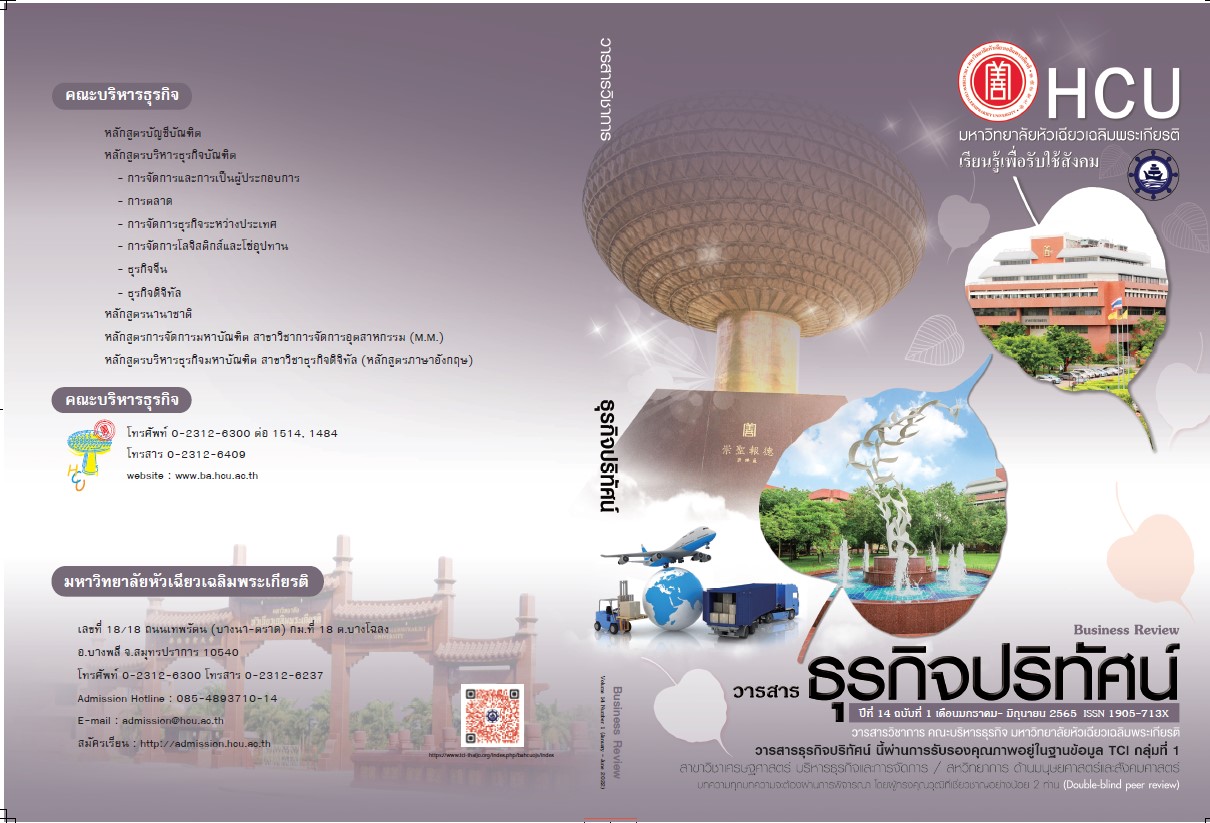The Analysis of MICE Components, Marketing Mix, and Measure the Success of Thai MICE Industry
Keywords:
MICE Marketing, MICE Elements, MICE Marketing Mix, Measurement of success for the MICE IndustryAbstract
The research objectives are to (1) study the meaning of MICE marketing, the MICE marketing components (2) define the MICE marketing mix, and measure the success of the Thai MICE industry. This research is a qualitative research which involved 21 MICE stakeholders include the government, private sector, and education sectors, comprising 11 in-depth interviews and 10 focused groups. Analysis of the data using information obtained from in-depth interviews and focused group discussions. To prepare and analyze the information through content analysis. The research results were found that the meaning of MICE marketing is an activity that creates trading, business expansion by using the MICE industry as a marketing platform. Generate revenue and income for the MICE organizer as well as the profit for the area of organizing MICE activities. The components of the MICE market are 6 components. The MICE marketing mix can be defined in 13 topics and the success measurement for Thai MICE industry also defines to 6 topics which are Infrastructure & Accessibility, MICE Management Standard, Country Ranking, Number of MICE Activities, Economic Impact, and Customer Perceived Value.
References
เกิดศิริ เจริญวิศาล. (2552). รูปแบบส่วนประสมทางการตลาดที่เหมาะสมของสถานที่จัดงานสำหรับอุตสาหกรรมไมซ์ในประเทศไทย. ปริญญาปรัชญาดุษฎีบัณฑิต สาขาวิชาพัฒนาการท่องเที่ยวสำนักงานบัณฑิตศึกษา, มหาวิทยาลัยแม่โจ้.
กันตภพ บัวทอง. (2554). กลยุทธ์การพัฒนาตลาด MICE ของจังหวัดชายแดนริมแม่น้ำโขง.วิทยานิพนธ์ปริญญาธุรกิจมหาบัณฑิต บัณฑิตวิทยาลัย, มหาวิทยาลัยขอนแก่น.
ดุษฎี ช่วยสุข และดลฤทัย โกวรรธนะกุล. (2558). การพัฒนาศักยภาพอุตสาหกรรมไมซ์ในจังหวัดขอนแก่นเพื่อรองรับการเป็นไมซ์ซิตี้ของประเทศไทย. วารสารบริการและการท่องเที่ยว, 10(1), 1-23.
ดร.เสรี วงษ์มณฑา และดร.วิชยานันท์ พ่อค้า. (2017). แนวทางการเสริมสร้างศักยภาพของประเทศไทยให้เป็นเมืองเป้าหมายของไมซ์ (MICE). มนุษยศาสตร์ปริทรรศน์: วารสารมนุษยศาสตร์, 96-112.
บุญเลิศ จิตตั้งวัฒนา. (2554). ธุรกิจไมซ์ (MICE BUSINESS). นนทบุรี: เฟิร์นข้าหลวง พริ้นติ้งแอนด์พับลิชชิ่ง.
พินิตา แก้วจิตคงทอง และเยาวลักาณ์ ชาวบ้านโพธิ์. (2016). ปัจจัยที่ส่งผลต่อการเลือกใช้บริการการจัดประชุมและสัมมนา (MICE) ของธุรกิจโรงแรมและรีสอร์ทในจังหวัดกาญจนบุรี. วารสารวิจัยมหาวิทยาลัยเวสเทิร์น มนุษยศาสตร์และสังคมศาสตร์, 35-46.
วันเฉลิม จันทร์พงษ์แก้ว. (2560). คุณค่าทางการสื่อสารและมูลค่าทางธุรกิจของสตรีทอาร์ท. ปริญญานิพนธ์การศึกษามหาบัณฑิต, มหาวิทยาลัยกรุงเทพ.
สำนักงานส่งเสริมการจัดประชุมและนิทรรศการ (องค์การมหาชน). (2562). รายงานงบประมาณประจำปี 2562. กรุงเทพฯ.
สำนักงานส่งเสริมการจัดประชุมและนิทรรศการ (องค์การมหาชน). (2563). หลักเกณฑ์การประเมินเมืองเพื่อเป็นไมซ์ซิตี้. กรุงเทพฯ.
อภิสิทธิ์ ฉัตรทนานนท์. (2547). “การบริหารการตลาด”, ในเอกสารประกอบการเรียนหลักสูตรการพัฒนาการจัดการ. กรุงเทพฯ: สถาบันบัณฑิตพัฒนบริหารศาสตร์.
Crouch, G.I., & Weber, K. (2002). Marketing convention of tourism. Journal of ConventionTourism International Research and Industry Perspectives. Binghamton New York: The Haworth Press.
Davidson, R., & Cope, B. (2003). Business Travel. Conferences, Incentive Travel, Exhibitions, Corporate Hospitality and Corporate Travel. Pearson Education: Harlow.
Kotler, P. (2012). Marketing Management (The Millennium edition). Upper Saddle River, NJ: Prentice Hall.
Kotler, P. (2016). Marketing management: Analysis, planning, implementation, and control (15th Global ed.). Upper Saddle River, NJ: Prentice-Hall.
MICE Industry by Event Type. Global Opportunity Analysis and Industry Forecast, 2018-2025.Retrieved August 9, 2020, from Allied Market Research Website:https://www.alliedmarketresearch.com/mice-industry-market.
MICE Intelligence Center. (2020) ถอดบทเรียนหนึ่งปี MICE Intelligence จากเทรนด์หลากหลายสู่งานไมซ์ยุค New Normal. สืบค้นเมื่อ 3 สิงหาคม 2564, จาก สำนักงานส่งเสริมการจัดประชุมและนิทรรศการ เว็บไซต์:https://intelligence.businesseventsthailand.com/en/blog/m2i.
Natalia, S. (2017). The internationalization of the Meetings-, Incentives-,Conventions-and Exhibitions- (MICE) industry: Its influences on the actors in the tourism business activity. Journal of Economics and Management, 27 (1), 96-113.
PATA Asia Pacific Association Issues and Trends. (2011). Bangkok: Pata Asia Pacific Association.
Rogers, T. (2000). “Destination Industry” Conference: A twenty-First Century. New York:Addition Wesley Longman.
Shankar, B. (2018). Global MICE Industry is projected to reach $1,439.3 Billion, in 2025. Retrieved August 3, 2020, from Allied Market Research Website: https://www.alliedmarketresearch.com/press-release/MICE-industrymarket.html#:~:text=According%20to%20a%20new%20report,7.6%25%20from%202018%20to%202025.
Swarbrooke, J., & Horner, S. (2001). Business Travel and Tourism. Oxford: Butterworth-Heine-mann.
Thailand Convention & Exhibition Bureau. (2020). Thai MICE United (Online). Retrieved August 3, 2020, from MICE in Thailand Website: https://www.facebook.com/miceinthailand/videos/624459911794875.
UNWTO. (2006). Measuring the Economic Importance of the Meetings Industry – Developing a Tourism Satellite Account Extension. Madrid.
Weber, K., & Chon, K. (2002). Convention tourism: international research and industry perspectives. New York: Haworth Hospitality Press.
Downloads
Published
How to Cite
Issue
Section
License
Copyright (c) 2022 Business Review Journal

This work is licensed under a Creative Commons Attribution-NonCommercial-NoDerivatives 4.0 International License.
All articles published in the Business Administration and Management Journal Review are copyrighted by the journal.
The views and opinions expressed in each article are solely those of the individual authors and do not represent those of Huachiew Chalermprakiet University or any other faculty members. Each author is fully responsible for the content of their own article. Any errors or issues found are the sole responsibility of the respective author.




